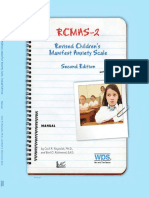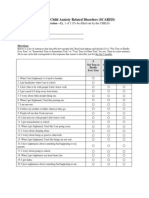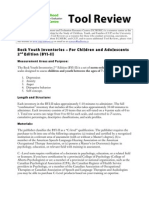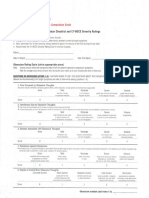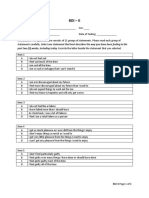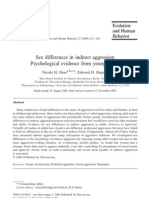Child Depression Inventory Cdi Interpretation
Child Depression Inventory Cdi Interpretation
Uploaded by
Gerlinde M SchmidtCopyright:
Available Formats
Child Depression Inventory Cdi Interpretation
Child Depression Inventory Cdi Interpretation
Uploaded by
Gerlinde M SchmidtOriginal Description:
Copyright
Available Formats
Share this document
Did you find this document useful?
Is this content inappropriate?
Copyright:
Available Formats
Child Depression Inventory Cdi Interpretation
Child Depression Inventory Cdi Interpretation
Uploaded by
Gerlinde M SchmidtCopyright:
Available Formats
Interpreting the Child Depression Inventory (CDI)
Interpretation of Test Score Patterns: One common clinical practice is to interpret the overall profile of test results according to the most elevated test scores. In such a case, a clinically elevated test score (T-score) is defined as one that is above 65. If no T-scores are above 65, the profile is usually considered to be indicative of a normal pattern. When elevated scores exist, they may appear in just one area indicating a focal point of concern, or several scales may be elevated indicating more pervasive problems.
Note: The school counselors use of the CDI is to be used as a tool to start a dialogue with the student and for parents to use as they wish. Under ideal circumstances, parents would opt to follow up with a professional who can pursue further evaluation if warranted. The Utah Model for Comprehensive Counseling and Guidance states that it is inappropriate for School Counselors to work with one student at a time in a therapeutic, clinical mode. Further direction in emergency situations can be found under two of Weber School Districts Policies: 4195 Emergency Medical Situations; and 4430 Student Testing Prohibition Without Prior Written Notice.
T-Scores: It is important to recognize that the raw test scores are converted to T-scores on the Profile Forms, and to know how T-scores are interpreted. Each scale has a mean of 50 and a standard deviation of 10. As a general rule of thumb, T-scores can be interpreted using the table below. These guidelines describe how an individual childs scores compare to those of children in the same age range and gender from the normative sample. Note that these suggested adjectives are merely approximate guidelines, and there is no reason to believe that there is a perceptible difference, for instance, between a T-score of 55 and a T-score of 56. Do not use these guidelines as absolute rules. Interpretive Guidelines for CDI T-scores T-score Above 70 66 to 70 61 to 65 56 to 60 45 to 55 40 to 44 35 to 39 30 to 34 Below 30
Interpretation of Overall Symptoms/Complaints
Very much above average Much above average Above average Slightly above average Average Slightly below average Below average Much below average Very much below average
It is important to place the Total CDI Score in the correct column on the Profile Form. Example: A male student, age 13-17, with a Total CDI score of 24 would equal a T-Score of 65, thus slightly above average. A female student, age 13-17, with a Total CDI score of 24 would equal a T-score of 73, thus very much above average.
Page 1 of 2
Interpretation of the Five Factor Scores: One useful way of interpreting the CDI is through the interpretation of the Total and individual Five Factor scores. The Total and Five Factor scores are compared to norms for appropriate groups of children; that is, the transformed scores provide information about how the child compares to children not specifically identified as having a diagnosable depression disorder. High scores suggest a problem while low scores indicate the absence of a problem. Definitions of the Subscales of the CDI Self-Report Five Factors Scale Negative Mood ______Definition_________________________________ This subscale reflects feeling sad, feeling like crying, worrying about bad things, being bothered or upset by things, and being unable to make up ones mind. This subscale reflects problems and difficulties in interactions with people, including trouble getting along with people, social avoidance, and social isolation. This subscale reflects negative evaluation of ones ability and school performance. This subscale reflects endogenous depression, including impaired ability to experience pleasure, loss of energy, problems with sleep and appetite, and a sense of isolation. This subscale reflects low self-esteem, self-dislike, feelings of being unloved, and a tendency to have thoughts of suicide.
Interpersonal Problems
Ineffectiveness Anhedonia
Negative Self-Esteem
CDI Short (CDI:S) Version: The 10-item CDI Short version was developed to provide a more rapid assessment of depressive symptoms. It is appropriate for K-12.
Sources: Childrens Depression Inventory Manual, 2003 Utah Model for Comprehensive Counseling and Guidance Utah Code 53A-13-302 Weber School District Policies 4195 and 4430 SAllen 2009; Updated 5/13
Page 2 of 2
You might also like
- Beck Youth InventoryDocument2 pagesBeck Youth InventoryHina Abbas Khan35% (34)
- Manual For The Child Behavior Checklist and Revised Child - Achenbach, Thomas M., 1940Document248 pagesManual For The Child Behavior Checklist and Revised Child - Achenbach, Thomas M., 1940Pablo Jacinto100% (3)
- Conners' Parent Rating Scale-Revised (S)Document2 pagesConners' Parent Rating Scale-Revised (S)Nor Zulaikha76% (17)
- Child Behavior Checklist (CBCL) PDFDocument3 pagesChild Behavior Checklist (CBCL) PDFRocio Jimenez Carcamo50% (8)
- Beck Youth Inventories - For Children andDocument12 pagesBeck Youth Inventories - For Children andNarmin Abida36% (11)
- Revised Childrens Manifest Anxiety ScaleDocument3 pagesRevised Childrens Manifest Anxiety ScaleAnita Rosalina100% (8)
- Judith Weston - Directing ActorsDocument387 pagesJudith Weston - Directing ActorsIrina Istratescu96% (24)
- The Revised Children'S Manifest Anxiety Scale (Rcmas) : "What I Think and Feel"Document3 pagesThe Revised Children'S Manifest Anxiety Scale (Rcmas) : "What I Think and Feel"Rizal Saeful Drajat100% (1)
- Rcmas-2 Manual Chapter 1Document4 pagesRcmas-2 Manual Chapter 1Oyiq Yarsi0% (3)
- Child Behavior Checklist 4-18Document16 pagesChild Behavior Checklist 4-18Abhijit Karegaonkar40% (5)
- Manual PDFDocument159 pagesManual PDFDoniLeite50% (4)
- Rcmas ScoringDocument6 pagesRcmas ScoringRizal Saeful Drajat50% (6)
- Conners 3 Self Report Assessment PDFDocument18 pagesConners 3 Self Report Assessment PDFJohan ZuñigaNo ratings yet
- Appendix 1 - ADHD Rating ScaleDocument2 pagesAppendix 1 - ADHD Rating Scalepunk_rock_sista295675% (4)
- Conners Comprehensive Behavior Rating ScaleDocument28 pagesConners Comprehensive Behavior Rating ScaleAnnisa Chaerani Burhanuddin67% (6)
- ChilddepressioninventoryDocument3 pagesChilddepressioninventoryapi-373494982100% (3)
- Children S Depression InventoryDocument1 pageChildren S Depression Inventoryapi-326282879No ratings yet
- Conners 3 Parent Assessment ReportDocument19 pagesConners 3 Parent Assessment ReportEspíritu Ciudadano100% (3)
- Staxi-2 CaDocument61 pagesStaxi-2 CaGerlinde M Schmidt100% (3)
- Jeffery Yuen Luo NotesDocument66 pagesJeffery Yuen Luo Notespranaji100% (25)
- Anxiety Scale - ChildDocument2 pagesAnxiety Scale - Childbrian@coombsmd.com90% (21)
- Conners QuestionaireDocument1 pageConners QuestionaireSaiPremaVijayawada100% (1)
- DSM Oriented Guide For The ASEBADocument45 pagesDSM Oriented Guide For The ASEBACarla Gaspar Duarte100% (1)
- Beck Youth Inventoiry: Property BYIDocument2 pagesBeck Youth Inventoiry: Property BYIanaq7033% (3)
- BYI II Tool ReviewDocument4 pagesBYI II Tool ReviewAhmed Al-Far100% (1)
- SDQ English (UK) 4-17scoringDocument3 pagesSDQ English (UK) 4-17scoringprithiksNo ratings yet
- CDI 2 Self-Report Assessment Report - SAMPLEDocument7 pagesCDI 2 Self-Report Assessment Report - SAMPLEJulianaTeixeira0% (1)
- Obsessive-Compulsive Disorder (OCD) Screening ToolDocument2 pagesObsessive-Compulsive Disorder (OCD) Screening ToolManiya Dianne ReyesNo ratings yet
- IPDE Personality Disorder. Questionnaire andDocument15 pagesIPDE Personality Disorder. Questionnaire andNasitha Nazreen100% (2)
- BDI ScaleDocument3 pagesBDI ScaleDeborah Bravian TairasNo ratings yet
- Yale - Brown Obsessive Compulsive Scale (Y-BOCS) Assessment-ToolsDocument44 pagesYale - Brown Obsessive Compulsive Scale (Y-BOCS) Assessment-ToolsMilos100% (1)
- SCID EnglDocument223 pagesSCID EnglAna Ilic100% (4)
- Assessment of Personality DisorderDocument19 pagesAssessment of Personality DisorderTanyu Mbuli Tidoline0% (1)
- Insight Paper - Crisis Intervention ModelsDocument10 pagesInsight Paper - Crisis Intervention ModelsANA VERONICA CONCEPCIONNo ratings yet
- Parenting Stress IndexDocument3 pagesParenting Stress IndexArif Rohman MansurNo ratings yet
- Scoring Instructions For The Beck Inventories 1Document2 pagesScoring Instructions For The Beck Inventories 1Philip fred100% (5)
- Depression Scale - ChildDocument2 pagesDepression Scale - Childbrian@coombsmd.com100% (8)
- Sample: Conners 3-Teacher Assessment ReportDocument20 pagesSample: Conners 3-Teacher Assessment ReportSergiEstella100% (1)
- Atkinson - Introducere in Psihologie, Partea 2Document505 pagesAtkinson - Introducere in Psihologie, Partea 2Ida Maria100% (10)
- 2010 Bushman&Huesmann Aggression HandbooksocialDocument31 pages2010 Bushman&Huesmann Aggression HandbooksocialGerlinde M SchmidtNo ratings yet
- The Enneagram Personality TestDocument18 pagesThe Enneagram Personality TestVicky Hsu100% (2)
- How NASA Builds Teams 0Document9 pagesHow NASA Builds Teams 0ethernalxNo ratings yet
- Childhood Behavior Checklist (CBCL) : The Child Behavior Checklist For Ages 6-18 IsDocument2 pagesChildhood Behavior Checklist (CBCL) : The Child Behavior Checklist For Ages 6-18 IsNazema_Sagi50% (2)
- CAPA - Parent Child Relationship ScaleDocument9 pagesCAPA - Parent Child Relationship ScaleAJNo ratings yet
- Instructions: Below Are A Number of Common Problems That Children Have in School. Please Rate Each Item According ToDocument1 pageInstructions: Below Are A Number of Common Problems That Children Have in School. Please Rate Each Item According ToKarina Espina Figueroa100% (1)
- Cdi2 Handout - Angela Jenn-1Document3 pagesCdi2 Handout - Angela Jenn-1api-206142283No ratings yet
- CDI Maria KovacsDocument3 pagesCDI Maria KovacsWentyAnggrainiNo ratings yet
- Child's Name: Birthdate - / - / - / Age: School Grade: Parent's Name: Today's Date - / - / - / GenderDocument1 pageChild's Name: Birthdate - / - / - / Age: School Grade: Parent's Name: Today's Date - / - / - / GenderStefania PazNo ratings yet
- Teenage DepressionDocument1 pageTeenage DepressionMarl Vincent MadroneroNo ratings yet
- Cy BocsDocument2 pagesCy BocsMuh Afdhol100% (1)
- Beck Depression InventoryDocument6 pagesBeck Depression Inventorywsergio0072100% (3)
- Bdi - Ii: Instructions: This Questionnaire Consists of 21 Groups of Statements. Please Read Each Group ofDocument5 pagesBdi - Ii: Instructions: This Questionnaire Consists of 21 Groups of Statements. Please Read Each Group ofPaul Benavidez100% (1)
- CBCL DSM PDFDocument2 pagesCBCL DSM PDFArmando CasillasNo ratings yet
- CBRS-Self-Report Assessment ReportDocument24 pagesCBRS-Self-Report Assessment ReportRafael Sanchez0% (3)
- Sample CBCL NarrativeDocument1 pageSample CBCL NarrativeMohamed Abozeid100% (1)
- Diagnostic Parent Rating Scale 1Document3 pagesDiagnostic Parent Rating Scale 1Yet Barreda Basbas100% (2)
- Completing The Auchenbach Child Behavior Checklist (CBCL) Tip SheetDocument2 pagesCompleting The Auchenbach Child Behavior Checklist (CBCL) Tip Sheetreefknot303No ratings yet
- Conners 3 Teacher Short - 104024 - 240207 - 113408Document7 pagesConners 3 Teacher Short - 104024 - 240207 - 113408AndreaLopez100% (1)
- Standardised Non Standardised1Document2 pagesStandardised Non Standardised1poornimaNo ratings yet
- Psychological TestingDocument24 pagesPsychological Testingzoyaaak201No ratings yet
- Insights From AGS Development Scores of Scores-The Art of Keeping Them Straight!Document3 pagesInsights From AGS Development Scores of Scores-The Art of Keeping Them Straight!Elizabeth MunozNo ratings yet
- SPL-3 Unit 4Document5 pagesSPL-3 Unit 4Divyank SurumNo ratings yet
- Child and Adolescent Screening and Assessment ToolsDocument28 pagesChild and Adolescent Screening and Assessment ToolsHeena Jain100% (1)
- Bandura + Projective TechniquesDocument33 pagesBandura + Projective TechniquesRinto RobertNo ratings yet
- Rotter Incomplete Sentences Blank (RISB) - Final TermDocument45 pagesRotter Incomplete Sentences Blank (RISB) - Final Termrameenshanza7No ratings yet
- Rotter Incomplete TenseDocument8 pagesRotter Incomplete TenseSaqib Ali KhokharNo ratings yet
- Temperament and Personality QuestionnaireDocument27 pagesTemperament and Personality QuestionnaireRaghav RavichandranNo ratings yet
- Djectives Describing PeopleDocument2 pagesDjectives Describing PeopleGerlinde M SchmidtNo ratings yet
- Madeleine Thomas Stories TestDocument3 pagesMadeleine Thomas Stories TestGerlinde M Schmidt50% (2)
- Einstein, Albert (1879-1955), German-Born American Physicist and NobelDocument7 pagesEinstein, Albert (1879-1955), German-Born American Physicist and NobelGerlinde M SchmidtNo ratings yet
- Journal Information Journal TOC Permissions: PsycarticlesDocument2 pagesJournal Information Journal TOC Permissions: PsycarticlesGerlinde M SchmidtNo ratings yet
- Sex Differences in Indirect Aggression Psychological Evidence From Young AdultsDocument15 pagesSex Differences in Indirect Aggression Psychological Evidence From Young AdultsGerlinde M SchmidtNo ratings yet
- Maslow's Needs TheoryDocument14 pagesMaslow's Needs TheoryKadene DarbyNo ratings yet
- Sample Report of Thumbrule DMIT (Dermatoglyphics Multiple Intelligence Test)Document29 pagesSample Report of Thumbrule DMIT (Dermatoglyphics Multiple Intelligence Test)Karan Behl100% (5)
- Cartomancy Gypsy Oracle CardsDocument11 pagesCartomancy Gypsy Oracle Cardsloving care100% (2)
- Family TherapyDocument135 pagesFamily TherapyFahri GunawanNo ratings yet
- PERFECTIONISTDocument2 pagesPERFECTIONISTBai Mei GuiNo ratings yet
- Uts GroupDocument16 pagesUts Groupchesca macaraigNo ratings yet
- Ethics - Modules - Midterm - Final Period - Miriam L. Espino - 1-11-24Document40 pagesEthics - Modules - Midterm - Final Period - Miriam L. Espino - 1-11-24John Benedict AquinoNo ratings yet
- Physical Evidence - Service MarketingDocument3 pagesPhysical Evidence - Service MarketingSwetakshi GolderNo ratings yet
- Pre K How We Express Ourselves Pre Kindergarten Sy14 15 PDFDocument7 pagesPre K How We Express Ourselves Pre Kindergarten Sy14 15 PDFsugunaNo ratings yet
- Chapter 6 PDF Coping Up With Stress in Middle and Late AdolescenceDocument23 pagesChapter 6 PDF Coping Up With Stress in Middle and Late AdolescenceJen E. BallatNo ratings yet
- Neuroticism Mindfulness and SleepDocument9 pagesNeuroticism Mindfulness and SleepJovan ErlandoNo ratings yet
- Daniel KahnemanDocument5 pagesDaniel KahnemanKassie PapasotiriouNo ratings yet
- Organizational Behavior: Stephen P. RobbinsDocument9 pagesOrganizational Behavior: Stephen P. RobbinssonamkbrNo ratings yet
- Your Hearts DesireDocument9 pagesYour Hearts Desirecheen13No ratings yet
- HBO - PPTmIIDocument26 pagesHBO - PPTmIIDave DinopolNo ratings yet
- Encyclopedia of Social EngineeringDocument37 pagesEncyclopedia of Social EngineeringJesus GraciaNo ratings yet
- Chapter 14 Psychological Disorders Practice Problems - AnswersDocument13 pagesChapter 14 Psychological Disorders Practice Problems - AnswersisraNo ratings yet
- Midterm Exam EssayDocument2 pagesMidterm Exam EssayJohn Drex CustodioNo ratings yet
- Workplace Emotions and AttitudesDocument27 pagesWorkplace Emotions and AttitudesDr Rushen SinghNo ratings yet
- Emotional Intelligence: History and SignificanceDocument36 pagesEmotional Intelligence: History and SignificancePLS1991No ratings yet
- Temper Tantrums - Blessed Flower EssencesDocument10 pagesTemper Tantrums - Blessed Flower EssencesMayil VeeraNo ratings yet
- Psycholinguistic & Emotional Aspects of StutteringDocument13 pagesPsycholinguistic & Emotional Aspects of StutteringMaria Garcia GuardaNo ratings yet
- Legends On Four LegsDocument23 pagesLegends On Four LegsRobin MorrisNo ratings yet
- Dietrich Doerner - PSI - A Computational Architecture of Cognition, Motivation, and EmotionDocument21 pagesDietrich Doerner - PSI - A Computational Architecture of Cognition, Motivation, and EmotionJoseph WhiteNo ratings yet
- Exam 2Document26 pagesExam 2Joseph MatthewsNo ratings yet








